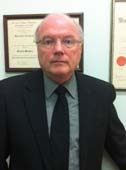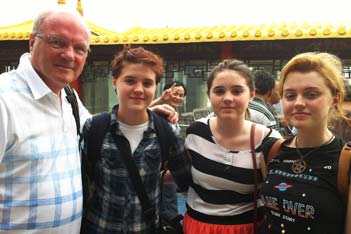Visiting China in the Tradition of Norman Bethune

Al Lossing
|
Lee Errett, the President of the
Bethune Foundation, asked Al
Lossing to travel to China to
update their vascular surgeons.
Al emphasized endovascular
techniques and observed and
assisted surgeons in the operating
room. “The surgeons are thirsty
for knowledge. Some are very
advanced and many are working
with much less advanced
techniques”. Approximately 200 people attended each
lecture. All the lectures were translated from English to
Chinese. David Dai, who organized the trip was very
helpful and was the translator throughout the entire
visit. As the trip progressed, Al discovered that the interest
in Telemedicine and the possible connection with
Canada became the highlight of the lectures. Al is the
Telemedicine Director at St. Michael’s Hospital. All of
the Chinese participants became very interested in establishing
a relationship with the University of Toronto
via Telemedicine, including not only the surgeons, but
ministers of health, CEOs, nurses, and physiotherapists.
His daughters Katherine (14), Jacqueline (16), and
Danielle (18) travelled with him and were treated as
celebrities. People enjoyed taking pictures of them - they
were a fascinating contrast to the one child policy. The
Lossing girls were escorted by residents and scientists
during the day, while Al gave his lectures. They saw
people sweeping the streets with handmade brooms
and the extremes of poverty. They travelled every 2 to
3 days, dined with the surgeons, administrators, CEOs
and ministers. “The girls’ experience was wonderful.
They came to appreciate Canada’s culture, healthcare,
and schools in ways that they could never otherwise
have known. They now communicate with friends and
nursing students from China. The girls gave a talk called
‘A Day in the Life of a Canadian Teenager’ which was
much appreciated. They were there for three weeks, flying
first to Beijing and travelling throughout Central
and Southern China and returning to Beijing.”
“I visited many operating rooms. The instruments
were primitive - Metzenbaum scissors, snaps, thumb forceps
and scalpels were all that was needed or used. There
was no electrocautery. In most hospitals, the corridors
and floors were empty of equipment, unlike Canadian
hospitals. There was very little aneurysmal surgery. The
volume of peripheral vascular disease was staggering
including complications of diabetes mellitus.”
|

Al, Danielle, Jacqueline and Katherine Lossing
In Nanning, they were introduced to a fascinating
surgeon (Dr. Tsui) at a 4,000 bed hospital. Each day
approximately 3000 patients are seen in out-patient clinics.
Dr. Tsui is a hepatobiliary surgeon, who, herself sees
about 70 patients in 2 hours. She told amazing stories of
being raised during the cultural revolution. Her mother
was a pediatrician and her father was in the military.
Al met a 90 year old gentleman who had worked with
Norman Bethune in North East China, and now oversees
and cares for a local temple. “Everyone in China over 30
knows the story of Norman Bethune. Younger people who
grew up in the post-Mao era are not particularily informed
about Bethune, who was a medical hero and friend of Mao.
The hospitals and medical schools are very interested in
videoconferencing with the University of Toronto in the
same way the Mississauga Campus videoconferences with
the main campus.
“The most memorable experiences were seeing the Great
Wall of China and working with Chinese surgeons through
a translator while performing complex operations. Words
were not exchanged because of the language barrier, but the
communication through body language was flawless.”
M.M.
|